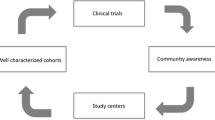Abstract
Spinal and bulbar muscular atrophy is an X-linked neuromuscular disease caused by an expanded repeat in the androgen receptor gene. The mutant protein is toxic to motor neurons and muscle. The toxicity is ligand-dependent and likely involves aberrant interaction of the mutant androgen receptor with other nuclear factors leading to transcriptional dysregulation. Various therapeutic strategies have been effective in transgenic animal models, and the challenge now is to translate these strategies into safe and effective treatment in patients.


Similar content being viewed by others
References
Banno H, Katsuno M, Suzuki K et al (2009) Phase 2 trial of leuprorelin in patients with spinal and bulbar muscular atrophy. Ann Neurol 65:140–150
Chevalier-Larsen ES, O’Brien CJ, Wang H et al (2004) Castration restores function and neurofilament alterations of aged symptomatic males in a transgenic mouse model of spinal and bulbar muscular atrophy. J Neurosci 24:4778–4786
Chua JP, Reddy SL, Merry DE et al (2014) Transcriptional activation of TFEB/ZKSCAN3 target genes underlies enhanced autophagy in spinobulbar muscular atrophy. Hum Mol Genet 23:1376–1386
Cortes CJ, Miranda HC, Frankowski H et al (2014a) Polyglutamine-expanded androgen receptor interferes with TFEB to elicit autophagy defects in SBMA. Nat Neurosci 17:1180–1189
Cortes CJ, Ling SC, Guo LT et al (2014b) Muscle expression of mutant androgen receptor accounts for systemic and motor neuron disease phenotypes in spinal and bulbar muscular atrophy. Neuron 82:295–307
Doi H, Adachi H, Katsuno M et al (2013) p62/SQSTM1 differentially removes the toxic mutant androgen receptor via autophagy and inclusion formation in a spinal and bulbar muscular atrophy mouse model. J Neurosci 33:7710–7727
Fernández-Rhodes LE, Kokkinis AD et al (2011) Efficacy and safety of dutasteride in patients with spinal and bulbar muscular atrophy: a randomised placebo-controlled trial. Lancet Neurol. 10:140–147
Fischbeck KH (2013) A role for androgen reduction treatment in Kennedy disease? Muscle Nerve 47:789
Grunseich C, Zukosky K, Kats IR et al (2014a) Stem cell-derived motor neurons from spinal and bulbar muscular atrophy patients. Neurobiol Dis 70:12–20
Grunseich C, Kats IR, Bott LC et al (2014b) Early onset and novel features in a spinal and bulbar muscular atrophy patient with a 68 CAG repeat. Neuromuscul Disord 24:978–981
Iida M, Katsuno M, Nakatsuji H et al (2015) Pioglitazone suppresses neuronal and muscular degeneration caused by polyglutamine-expanded androgen receptors. Hum Mol Genet 24:314–329
Katsuno M, Adachi H, Doyu M et al (2003) Leuprorelin rescues polyglutamine-dependent phenotypes in a transgenic mouse model of spinal and bulbar muscular atrophy. Nat Med 9:768–773
Katsuno M, Banno H, Suzuki K et al (2010) Efficacy and safety of leuprorelin in patients with spinal and bulbar muscular atrophy (JASMITT study): a multicentre, randomised, double-blind, placebo-controlled trial. Lancet Neurol 9:875–884
La Spada A, Wilson EM, Lubahn DB, Harding AE, Fischbeck KH (1991) Androgen receptor gene mutations in X-linked spinal and bulbar muscular atrophy. Nature 352:77–79
Lieberman AP, Yu Z, Murray S et al (2014) Peripheral androgen receptor gene suppression rescues disease in mouse models of spinal and bulbar muscular atrophy. Cell Rep 7:774–784
Minamiyama M, Katsuno M, Adachi H et al (2012) Naratriptan mitigates CGRP1-associated motor neuron degeneration caused by an expanded polyglutamine repeat tract. Nat Med 18:1531–1538
Miyazaki Y, Adachi H, Katsuno M et al (2012) Viral delivery of miR-196a ameliorates the SBMA phenotype via the silencing of CELF2. Nat Med 18:1136–1141
Palazzolo I, Burnett BG, Young JE et al (2007) Akt blocks ligand binding and protects against expanded polyglutamine androgen receptor toxicity. Hum Mol Genet 16:1593–1603
Palazzolo I, Stack C, Kong L et al (2009) Overexpression of IGF-1 in muscle attenuates disease in a mouse model of spinal and bulbar muscular atrophy. Neuron 63:316–328
Pandey UB, Nie Z, Batlevi Y et al (2007) HDAC6 rescues neurodegeneration and provides an essential link between autophagy and the UPS. Nature 447:859–863
Rinaldi C, Bott LC, Chen KL et al (2012) Insulin-like growth factor (IGF)-1 administration ameliorates disease manifestations in a mouse model of spinal and bulbar muscular atrophy. Mol Med 18:1261–1268
Rinaldi C, Bott LC, Fischbeck KH (2014) Muscle matters in Kennedy’s disease. Neuron 82:251–253
Sahashi K, Katsuno M, Hung G et al (2015) Silencing neuronal mutant androgen receptor in a mouse model of spinal and bulbar muscular atrophy. Hum Mol Genet 24(21):5985–5994
Shrader JA, Kats I, Kokkinis A et al (2015) A randomized controlled trial of functional exercise in spinal and bulbar muscular atrophy. Ann Clin Transl Neurol 2:739–747
Tokui K, Adachi H, Waza M et al (2009) 17-DMAG ameliorates polyglutamine-mediated motor neuron degeneration through well-preserved proteasome function in an SBMA model mouse. Hum Mol Genet 18:898–910
Waza M, Adachi H, Katsuno M et al (2005) 17-AAG, an Hsp90 inhibitor, ameliorates polyglutamine-mediated motor neuron degeneration. Nat Med 1:1088–1095
Yang Z, Chang YJ, Yu IC et al (2007) ASC-J9 ameliorates spinal and bulbar muscular atrophy phenotype via degradation of androgen receptor. Nat Med 13:348–353
Author information
Authors and Affiliations
Corresponding author
Rights and permissions
About this article
Cite this article
Fischbeck, K.H. Spinal and Bulbar Muscular Atrophy Overview. J Mol Neurosci 58, 317–320 (2016). https://doi.org/10.1007/s12031-015-0674-7
Received:
Accepted:
Published:
Issue Date:
DOI: https://doi.org/10.1007/s12031-015-0674-7




